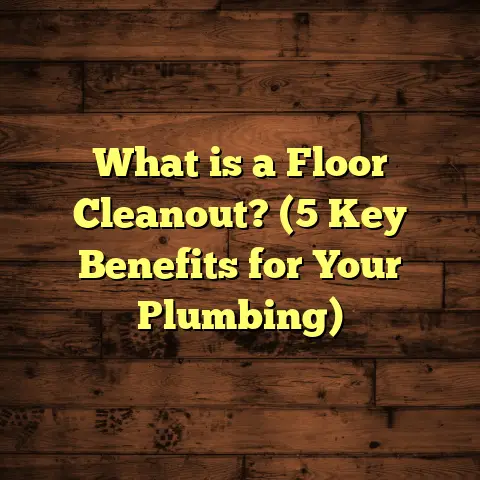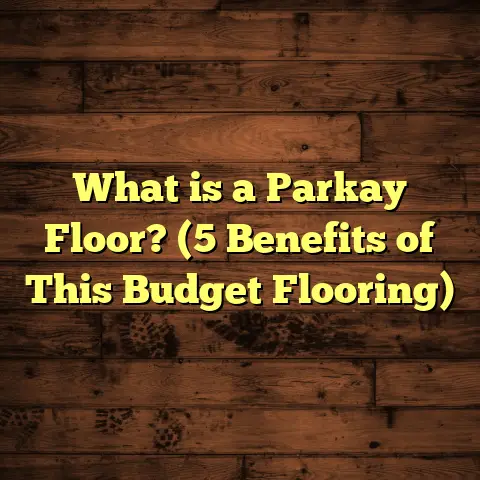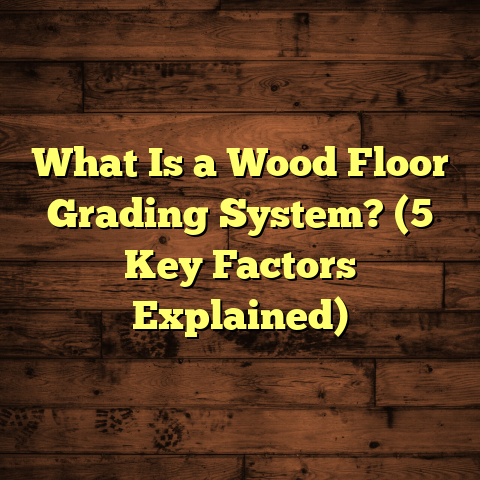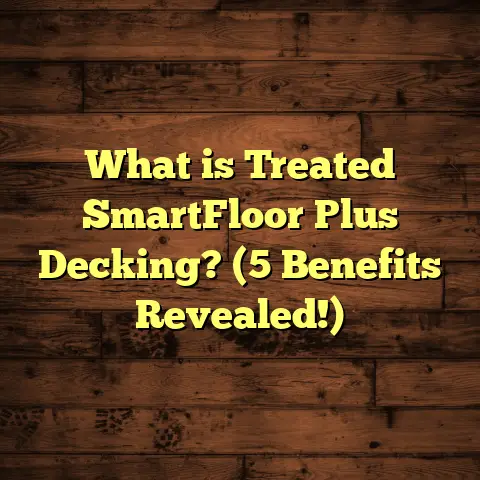What is VF Flooring? (5 Benefits of Luxury Vinyl Flooring)
Have you ever stepped into a room and felt instantly drawn to the floor? Maybe it was the rich grain of wood or the cool elegance of stone—but what if I told you there was a flooring option that looks just as good but handles life’s messes with way less fuss? I remember when I first came across VF flooring, and it really sparked my curiosity. The promise of floors that combine luxury looks with practical benefits made me dig deeper. If you’re considering new flooring and want something both beautiful and durable, you might find my experiences and insights helpful.
What is VF Flooring?
Let’s get clear on what I’m talking about when I say VF flooring. VF usually refers to Vinyl Flooring—more specifically, Luxury Vinyl Flooring (LVF) or Luxury Vinyl Tile (LVT). This type of flooring uses vinyl as a base material but takes it way beyond your typical cheap vinyl sheet. It’s designed with multiple layers that replicate the appearance of natural materials like hardwood, ceramic tile, or stone.
I like to think of luxury vinyl as the “chameleon” of floors—it can mimic almost any surface while offering durability and versatility that many natural materials struggle to match.
The Construction of VF Flooring: Why It Works So Well
Understanding what goes into luxury vinyl flooring helps explain why it’s become so popular. Here’s a breakdown of the typical layers:
- Wear Layer: This is a transparent protective coating that sits on top. It guards against scratches, scuffs, stains, and fading. The thickness of this layer directly impacts durability. I’ve seen wear layers ranging from 6 mils (for residential use) to over 20 mils (commercial-grade), and choosing the right thickness depends on where you plan to install the floor.
- Design Layer: This is where all the magic happens visually. A high-resolution photographic print creates the look—whether it’s rustic oak planks, smooth marble tiles, or even concrete textures. Modern printing technology and embossing techniques add texture that feels natural underfoot.
- Core Layer: The heart of the product. Most luxury vinyl has a solid core made from PVC vinyl or composite materials like WPC (Wood Plastic Composite) or SPC (Stone Plastic Composite). This core adds stability and makes the flooring more resistant to dents and moisture. SPC cores, for example, have crushed limestone mixed with PVC, making them denser and harder than WPC.
- Backing Layer: This is the foundation that supports the entire structure. It can provide moisture protection, sound dampening, or added comfort.
Different Types Under the VF Umbrella
There are several types of luxury vinyl flooring based on construction:
- Luxury Vinyl Plank (LVP): Designed to look like hardwood planks, often long and narrow.
- Luxury Vinyl Tile (LVT): Usually square or rectangular tiles mimicking stone or ceramic.
- Rigid Core Vinyl: Includes SPC and WPC varieties known for their firmness and water resistance.
I’ve installed all these types in different settings—from residential homes to busy offices—and each has its own strengths depending on the situation.
Why I Started Recommending VF Flooring: Five Big Benefits
Over the years, I’ve worked with many flooring materials—hardwood, laminate, tile, carpet—but VF flooring keeps standing out for several reasons. Let me walk you through five benefits that make luxury vinyl flooring worth considering.
1. Exceptionally Durable — Ready for Real Life
Durability is one of the first things I look for when recommending flooring. Life can be messy—kids running around, pets scratching, constant foot traffic—and your floor needs to keep up.
Luxury vinyl holds up well because of its tough wear layer and resilient core. In one project with a young family who had two energetic dogs and three kids under ten, they chose luxury vinyl plank for their entire main floor. After two years of daily wear—including muddy paws, spilled juice, and even a dropped cast iron skillet—the floor still looked great. No cracks in the planks, no fading, no noticeable scratches.
Here’s some data that backs this up: According to the Resilient Floor Covering Institute (RFCI), luxury vinyl flooring has an expected lifespan of 10 to 20 years with proper maintenance. That compares favorably to laminate flooring that may peel after 7-10 years or hardwood floors that can scratch easily if not carefully maintained.
In commercial settings, products with a thicker wear layer (12-20 mils) can handle thousands of footsteps daily without showing wear for 10+ years. So whether you have kids, pets, or a busy office space, VF flooring tends to keep its look longer than many alternatives.
2. Water Resistance That Makes a Difference
If you’ve ever spilled water on hardwood or laminate flooring, you know how fast it can cause damage—warping, swelling, or staining. When dealing with kitchens, bathrooms, basements, or laundry rooms where moisture is unavoidable, waterproof options become critical.
One client was hesitant about installing hardwood in their basement due to dampness concerns. I recommended luxury vinyl flooring because most products are 100% waterproof thanks to their solid vinyl core and protective layers. This means no warping or swelling if water spills or humidity rises.
The Environmental Protection Agency (EPA) highlights moisture as a major cause of indoor air quality problems linked to mold growth in homes. Having waterproof flooring minimizes these risks dramatically.
For example, SPC luxury vinyl’s stone composite core is completely impervious to water. Even if you flood your kitchen accidentally or sweat spills in a gym locker room, these floors won’t absorb moisture or deteriorate.
3. Style Options That Fit Any Taste
I remember when luxury vinyl floors looked pretty generic—flat colors with little texture. Now? The variety is incredible. You can find every style imaginable: distressed hardwood looks with knots and grains; sleek marble tiles with veining; rustic slate textures; even patterned encaustic tile designs.
A survey by Floor Covering Weekly found over 70% of homeowners rated luxury vinyl as visually comparable to natural materials—a huge jump from just a few years ago.
Because the design layer is printed at very high resolution and embossed with texture, the floors don’t just look real—they feel real too.
Plus, vinyl offers design flexibility that solid hardwood can’t match—you can install it over radiant heating systems or choose planks that lock together without glue for easy DIY projects.
I’ve had clients thrilled by how their VF floors transformed rooms without blowing their budgets on exotic woods or stones.
4. Installation Is Quick and Budget-Friendly
If you’ve ever watched a tile or hardwood floor install, you know it can be time-consuming—and expensive. Tile requires mortar setting and grout lines; hardwood demands acclimation and precise nailing or glue-down methods.
Luxury vinyl flooring installation tends to be faster and simpler. There are several methods:
- Click-Lock Floating Floor: Planks click together like puzzle pieces over an underlayment—super popular for DIYers.
- Glue-Down: Adhesive secures planks directly to subfloor—common in commercial settings.
- Loose Lay: Heavier vinyl planks that stay in place by weight alone—easy to remove later if needed.
In one recent project, I installed click-lock vinyl plank flooring in a 500-square-foot room in less than a day by myself. Compared to tile work that might take several days just for setting and grouting, this was a huge time saver.
Labor costs reflect this too: traditional tile installation can run $7-$15 per square foot in labor alone; whereas vinyl installation usually ranges from $2-$5 per square foot depending on complexity.
When planning these projects, I use FloorTally—a tool that helps me calculate materials needed, labor costs based on local rates, and even waste factors so I’m not caught short on supplies. It saves me time and keeps clients informed about budgeting from start to finish without surprises.
5. Comfort and Sound Absorption Underfoot
One unexpected benefit I noticed early on was how comfortable luxury vinyl floors feel compared to tile or hardwood.
Tile floors are hard and cold; hardwood can be unforgiving on knees if you stand for hours cooking or entertaining guests. Vinyl has a slight cushioning effect because of its flexible core layers—making it easier on your joints.
Many VF floors also come with an added backing layer designed for sound absorption. This reduces echo and footstep noise in busy households or multi-story buildings—a real plus if you live in an apartment or have noisy kids running around.
In one renovation for an elderly couple who loved cooking but had joint pain issues, luxury vinyl made standing at the stove much easier without sacrificing style.
More Insights From My Flooring Projects
After working with VF flooring across hundreds of installations, I’ve gathered some insights I’d love to share:
- Subfloor Preparation Matters: Even though vinyl is forgiving compared to tile or hardwood, your subfloor should be clean, level, and dry for best results. Uneven surfaces can cause plank flexing or premature wear.
- Don’t Skimp on Wear Layer Thickness: For high-traffic areas—or if you have pets—look for wear layers around 12 mils or higher. Thinner wear layers may save money upfront but won’t last as long.
- Choose SPC Core for Wet Areas: Stone Plastic Composite cores offer superior moisture resistance and dimensional stability compared to WPC or traditional vinyl cores. Great for bathrooms and basements.
- Match Your Décor: VF flooring comes in many colors and finishes—don’t hesitate to bring home samples before deciding. Lighting can affect how colors look in your space.
Data Snapshot: What Numbers Tell Us About VF Flooring
I’d like to highlight some statistics that helped me recommend luxury vinyl confidently:
| Feature | Typical Range / Value |
|---|---|
| Material Cost per Square Foot | $2 – $7 |
| Installation Cost per Square Foot | $2 – $5 |
| Average Lifespan | 10 – 20 years |
| Wear Layer Thickness | 6 mils (residential) up to 20+ mils (commercial) |
| Waterproof | Generally 100% waterproof |
| Scratch Resistance | High resistance with thicker wear layers |
These numbers come from various industry reports including RFCI data and Floor Covering Weekly surveys.
Case Study: Café Uses VF Flooring for Durability & Style
One installation I’ll never forget was for a local café owner who wanted durable yet stylish floors that could handle daily foot traffic plus occasional spills from coffee machines.
They chose a wood-look SPC luxury vinyl plank with a commercial-grade wear layer (20 mil). After six months of constant use—including heavy customers during morning rushes—the floor showed zero signs of wear or damage.
The café owner mentioned how much easier it was to clean compared to grout-lined tiles they had before—saving both time and cleaning products every day.
This project confirmed for me that VF flooring isn’t just great for homes; it’s highly practical for commercial spaces needing durability combined with style.
Using FloorTally To Plan My Flooring Projects
Budgeting is always a challenge when juggling material quality, installation labor, potential waste, and unexpected expenses like subfloor repair.
FloorTally has become my go-to tool for cost estimation because it lets me:
- Input exact room dimensions.
- Choose from an extensive library of materials.
- See local labor rate estimates.
- Factor in waste percentages (usually around 5-10% depending on layout).
- Generate detailed cost breakdowns quickly.
This helps me give clients realistic quotes from day one—and adjust plans if budgets shift without guesswork later on.
For DIYers considering VF flooring installation themselves, FloorTally also helps calculate how much product to buy so you avoid overspending or running short mid-project.
What About Maintenance? Keeping Your VF Floor Looking New
One big plus about luxury vinyl is how low maintenance it is compared to hardwood or carpet.
Here are some tips from my experience:
- Regular Sweeping or Vacuuming: Keep dirt and grit off the floor surface to prevent scratches.
- Damp Mop With Mild Cleaners: Avoid harsh chemicals or abrasive tools which can degrade the wear layer over time.
- Avoid Waxing or Polishing: Unlike hardwood, vinyl doesn’t need refinishing.
- Protect High-Traffic Areas: Consider rugs or mats near entrances where dirt accumulates.
- Clean Spills Quickly: Even though it’s waterproof, standing liquids should be wiped up promptly to avoid slipping hazards.
With these simple steps, your VF floor will stay beautiful for years—something my clients appreciate especially when balancing busy lives with home upkeep.
Can Luxury Vinyl Flooring Raise Your Home’s Value?
You might wonder if investing in VF flooring actually adds value to your property compared to hardwood or tile?
While hard surfaces generally increase home appeal more than carpeted floors during resale, luxury vinyl offers a strong balance between aesthetics and cost-effectiveness that buyers find attractive—especially families looking for durable options without high maintenance costs.
According to Remodeling Magazine’s Cost vs Value Report:
- Installing mid-range luxury vinyl plank has an ROI (return on investment) of around 70% nationally.
- Hardwood floors score slightly higher (~80%) but come with larger initial costs and upkeep.
So if you want solid value without overspending upfront—or want floors that will still look great after years of wear—VF flooring hits a sweet spot in many markets.
Common Questions I Get About VF Flooring
Is Luxury Vinyl Flooring Safe For Allergies?
Yes! Because it doesn’t trap dust and allergens like carpet does, luxury vinyl is often recommended for people with asthma or allergies. It’s also mold-resistant due to its waterproof nature—which helps keep indoor air quality better.
Can You Install Luxury Vinyl Over Existing Floors?
Often yes—if your current floor is flat and stable (like concrete slab or well-installed tile). This can save time and money by avoiding demolition work—but always check manufacturer guidelines before proceeding.
Does Luxury Vinyl Feel Cold Like Tile?
It depends on subflooring underneath. Adding foam underlayment can warm up the floor slightly; radiant heating systems work well too with vinyl plank floors—making them comfortable year-round.
How Long Does Installation Take?
For an average-sized room (300-500 sq ft), professional installation usually takes one day or less using click-lock planks. Glue-down may take longer due to adhesive curing times but still much quicker than tile setting/grouting processes.
Wrapping Up My Thoughts on VF Flooring
I hope this deep look into VF flooring gives you a clear picture of what it is—and why so many people (including me) have come to trust luxury vinyl for their homes and businesses. It combines durability, water resistance, design variety, easy installation, comfort—all at a reasonable price point that fits many budgets.
If you’re weighing options for your next flooring project, VF flooring deserves serious consideration—especially if you want something that looks amazing but won’t stress you out with maintenance or repairs down the line.
And remember: using good planning tools like FloorTally can make budgeting easier and keep your project on track from start to finish—helping avoid surprises no matter which flooring you choose.
If you want recommendations on specific brands or installation advice—or have questions about care—just reach out anytime! I’m always happy to share what I’ve learned after years on the job working hands-on with these fantastic floors.
Feel free to ask if you’d like me to expand any section further or add more personal stories!





